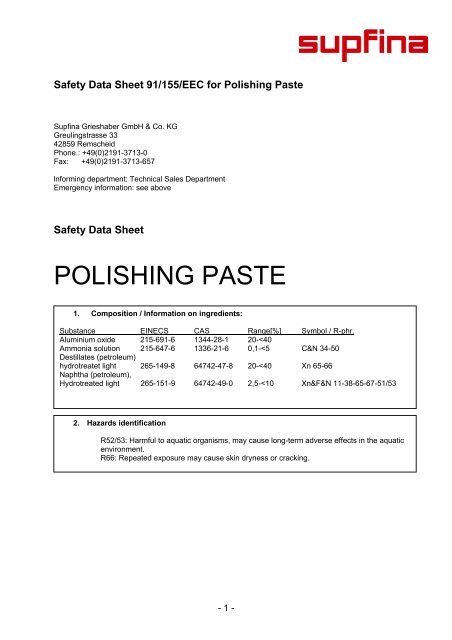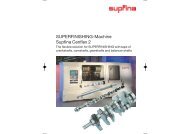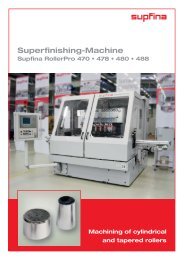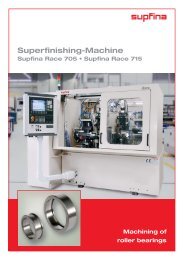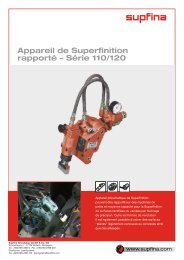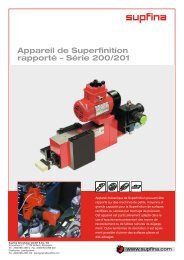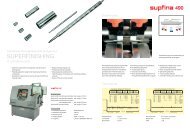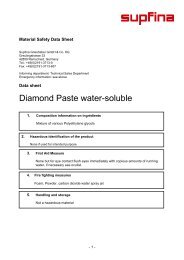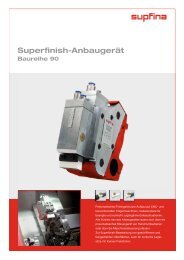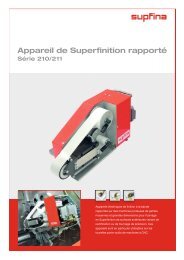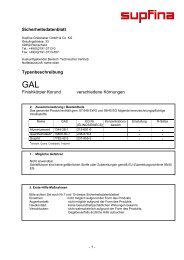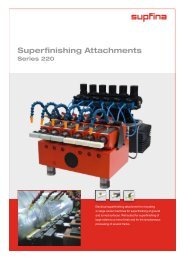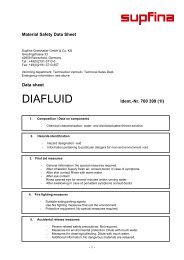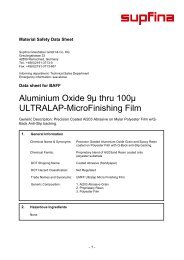POLISHING PASTE
POLISHING PASTE
POLISHING PASTE
You also want an ePaper? Increase the reach of your titles
YUMPU automatically turns print PDFs into web optimized ePapers that Google loves.
Safety Data Sheet 91/155/EEC for Polishing Paste<br />
Supfina Grieshaber GmbH & Co. KG<br />
Greulingstrasse 33<br />
42859 Remscheid<br />
Phone.: +49(0)2191-3713-0<br />
Fax: +49(0)2191-3713-657<br />
Informing department: Technical Sales Department<br />
Emergency information: see above<br />
Safety Data Sheet<br />
<strong>POLISHING</strong> <strong>PASTE</strong><br />
1. Composition / Information on ingredients:<br />
Substance EINECS CAS Range[%] Symbol / R-phr.<br />
Aluminium oxide 215-691-6 1344-28-1 20-
Safety Data Sheet<br />
3. First aid measures<br />
- General Infomation: Change soaked clothing<br />
- Inhalation: ensure supply of fresh air. In the event of symptoms refer for<br />
- medical treatment.<br />
- Skin contact: When in contact with skin, clean with soap and water.<br />
Consult a doctor if skin irritation persists.<br />
- Eye contact: In case of contact with eyes rinse thoroughly with plenty of water<br />
and seek medical advice<br />
- Ingestion: Rinse out mouth and give plenty of water to drink. Do not induce<br />
vomiting. Refer for medical treatment.<br />
- Advice to doctor: Treat Symptomatically<br />
4. Fire-fighting measures<br />
Suitable extinguishing media: Water spry jet, dry powder, Carbon dioxide, Foam.<br />
Extinguishing media that must not be used: None.<br />
Special exposure hazards arising from the substance or preperation itself or combustion<br />
products:<br />
Risks of formation of toxic pyrolysis products<br />
Special protective equipment for firefighters<br />
Use self-contained breathing apparaturs<br />
Additional information:<br />
Fire residues and contamined firefighting water must be disposed of in accordance with the local<br />
regulations<br />
5. Accidential release measures<br />
Personal precautions:<br />
High risk of slipping due to leakage/spillage of product. Ensure adequate ventilation. Keep away<br />
sources of ignition.<br />
Enviromental precautions:<br />
Do not discharge into the drains/surface waters/groundwater<br />
Methods for cleaning up/taking up<br />
Take up mechanically. Dispose of absorbed material in accordance with the regulations<br />
- 2 -
Safety Data Sheet<br />
7. Exposure controls / personal protection<br />
Additional advice on system design:<br />
Ingredients with occupational exposure limits to be monitored<br />
Substance CAS Value:<br />
1344-28-1 MAK: 6mg/m³ A 2000<br />
1336-21-6 MAK: 50ppm Y 2000<br />
Destillates (petroleum)<br />
Hydrotreated light 64742-47-8 MAK: 100ppm 2000<br />
Naphta (petroleum)<br />
Hydrotreated light 64742-49-0 MAK: 200ppm 2000<br />
Respiratory protection Normally not necessarily<br />
Hand protection: Protective gloves (DIN/EN 374)<br />
Eye protection: Safety glasses<br />
Skin protection: Not applicable<br />
General protectiv measures:<br />
Avoid contact with eyes and skin. Do not inhale vapours.<br />
Wash hands before breaks and after work. Use barrier skin cream.<br />
Limitation and controlling of the environment pollution<br />
8. Physical and chemical properties<br />
- Form: Pasty<br />
- Colour: Blue<br />
- Odour: Characteristic<br />
- pH-value: 9-10<br />
- Boiling point [°C]: -<br />
- Flash point [°C]: > 70<br />
- Flammability: -<br />
- Lower explosion limit: -<br />
- Upper explosion limit: -<br />
- Combustible properties: No<br />
- Vapour pressure [hPa]: (20°C) -<br />
- Density [g/ml]: 1,17<br />
- Solubility in water Partially soluble<br />
- Partition coefficient: n-octanol /<br />
water:<br />
- Viscosity: > 7mm²/s (40°C)<br />
- Relative vapour density determined<br />
In air -<br />
- Speed of evaporation -<br />
- Melting point [°C]: -<br />
- Augnition temperature: -<br />
9. Stability and reactivity<br />
Hazardous reactions: Reactions with oxidizing agents<br />
Hazardous decompition products: No harzardous decomposition products know<br />
- 3 -
Safety Data Sheet<br />
10. Toxicological information<br />
Acute oral toxicity: LD50 Rat: -<br />
Acute dermal toxicity: LD50: -<br />
Acute inhalation toxicity: LC50 Rabbit: -<br />
Irritant effect on eye<br />
Sensitization / Validation<br />
Mutagenicity / Validation<br />
Mutagenicity / Validation<br />
Reproduction toxicity / Validation<br />
Experiences made in practice None<br />
General remarks<br />
The product was classified on the basis of the calculation procedure of the preparation<br />
directive. No toxicological data are available.<br />
11. Ecological information<br />
Fish toxicity<br />
Behaviour in sewage plant<br />
AOX-advice:<br />
No dangerous components<br />
General information:<br />
Ecological data are not available<br />
Contains compounds of 76/464/EWG<br />
Yes<br />
12. Disposal considerations<br />
Disposal / Product<br />
Dispose of as hazardous waste<br />
Waste no: 160305*<br />
Disposal/Contaminated packaging<br />
Uncontaminated packaging may be taken for recycling. Packaging that cannot be cleaned<br />
should be disposed of as for product.<br />
- 4 -
Safety Data Sheet<br />
13. Transport Information<br />
13.1 Classification according to ADR<br />
ADR: not classified as Dangerous Goods<br />
Declaration:<br />
Labelling<br />
Factor, ADR 1.1.3.6.3<br />
Hazard-no.: -<br />
Label:<br />
ADR-Conditions für limited quantities (LQ) : -<br />
Dangerous Good Declaration: not classified as dangerous Goods<br />
Labelling<br />
Label:<br />
Inner packing, max.:<br />
Total gross mass of a package:<br />
13.2 Classification according to IMDG<br />
IMDG-Code: not classified as dangerous Goods<br />
Dangerous Goods Declaration:<br />
Labelling:<br />
Label<br />
IMDG-Conditions for limited quantities:<br />
Dangerous Goods declaration: not classified as dangerous Goods<br />
Labelling<br />
label:<br />
Inner packing, max.:<br />
Total gross mass of a package:<br />
13.3 Classification according to IATA<br />
IATA-DGR: not classified as dangerous Goods<br />
Dangerous Goods Declaration:<br />
Labelling:<br />
Label<br />
14. Regulatory information<br />
Labelling: The Product is labeled in accordance<br />
with EC directives Hazard symbols<br />
Hazard symbols:<br />
R52/53: Harmfull to aquatic organisms may cause long-term adverse effects in the aquatic<br />
evironment<br />
R66: Repeated exposure may cause skin dryness or cracking.<br />
S56: Dispose of this material and its container to hazardous or special waste collection point.<br />
Special labelling for certain preparations: Not applicable.<br />
National regulations: Not applicable<br />
- 5 -
Safety Data Sheet<br />
15. Other Informations<br />
R-phrases (Substance)<br />
R11: Highly flammable<br />
R34: Causes burns<br />
R38: Irritating to skin<br />
R50: Very toxic to aquatic organisms<br />
R51/53: Toxic to aquatic organisms, may cause long-term adverse effects in the aquatic<br />
environment<br />
R65: Harmful: may cause lung damage if swallowed<br />
R66: Repeated exposure may cause skin dryness or cracking.<br />
R67: Vapours may cause drowsiness and dizziness<br />
Regulatory information<br />
* 91/155/EWG (2001/58/EG)<br />
* 67/548/EWG (2001/59/EG)<br />
* 1999/45/EG (2001/60/EG)<br />
* 91/689/EWG (2001/118/EG)<br />
* 89/542/EWG<br />
* ADR (23.07.01)<br />
*IMDG-Code (30Amdt.)<br />
*ATA-DGR (2002)<br />
*Classification according to VbF<br />
Modified position:<br />
Not applicable<br />
- 6 -


